
Indonesian cuisine is a collection of various regional culinary traditions that formed in the archipelagic nation of Indonesia. There are a wide variety of recipes and cuisines in part because Indonesia is composed of approximately 6,000 populated islands of the total 17,508 in the world's largest archipelago, with more than 1,300 ethnic groups.
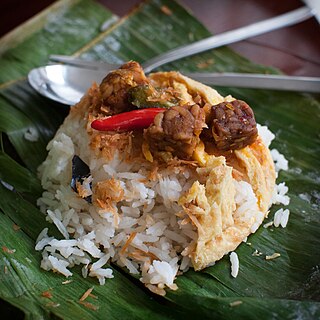
Nasi uduk is an Indonesian-style steamed rice cooked in coconut milk dish, especially popular in Betawi cuisine.

Sayur asem or sayur asam is an Indonesian vegetable soup. It is a popular Southeast Asian dish originating from Sundanese cuisine, consisting of vegetables in tamarind soup.
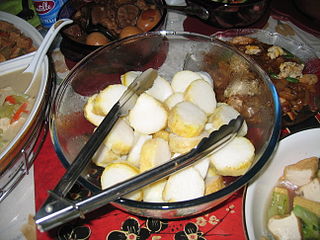
Lontong is an Indonesian dish made of compressed rice cake in the form of a cylinder wrapped inside a banana leaf, commonly found in Indonesia, Malaysia, and Singapore. Rice is rolled inside a banana leaf and boiled, then cut into small cakes as a staple food replacement for steamed rice. The texture is similar to that of ketupat, with the difference being that the ketupat container is made from woven janur fronds, while lontong uses banana leaf instead.

Javanese cuisine is the cuisine of Javanese people, a major ethnic group in Indonesia, more precisely the province of Central Java, Yogyakarta and East Java.

Kerak telor is a Betawi traditional spicy omelette dish in Betawi cuisine. It is made from glutinous rice cooked with egg and served with serundeng, fried shallots and dried shrimp as topping. It is considered as a snack and not as a main dish. The vendors of kerak telor are easily the most ubiquitous during the annual Jakarta Fair and it has also become a must-have menu item for visitors at the event.
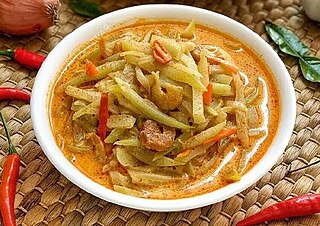
Sayur lodeh is a popular Indonesian vegetable soup prepared from vegetables cooked in coconut milk, and is most often associated with Javanese cuisine.

Semur is an Indonesian meat stew braised in thick brown gravy. It is commonly found in Indonesian cuisine. The main ingredients in the gravy are sweet soy sauce, shallots, onions, garlic, ginger, candlenut, nutmeg, and cloves.

Asinan is a pickled vegetable or fruit dish, commonly found in Indonesia. Asin, Indonesian for "salty", is the process of preserving the ingredients by soaking them in a solution of salty water. Asinan is quite similar to rujak, which is usually served fresh, while asinan is preserved vegetables or fruits. Of the many types and variations of asinan in Indonesia, the most popular are asinan Betawi and asinan Bogor. Asinan can be found in restaurants, warung, and travelling street vendor.

Nasi ulam is a traditional Indonesian dish of steamed rice (nasi) served with various herbs and vegetables (ulam).

Lontong cap go meh is a Chinese Indonesian take on traditional Indonesian dishes, more precisely Javanese cuisine. It is lontong served with richly-flavoured dishes which include opor ayam chicken in coconut milk, sayur lodeh vegetable soup, hot and spicy liver, hard-boiled pindang egg, koya powder made of soy and dried shrimp or beef floss, pickles, chili paste and prawn cracker. Lontong cap go meh is usually consumed by the Chinese Indonesian community during the Cap go meh celebration.

Betawi cuisine is rich, diverse and eclectic, in part because the Betawi people that create them were composed from numbers of regional immigrants that came from various places in the Indonesian archipelago, as well as Chinese, Indian, Arab, and European traders, visitors and immigrants that were attracted to the port city of Batavia since centuries ago.

Ketupat, or kupat, or tipat is a Javanese rice cake packed inside a diamond-shaped container of woven palm leaf pouch. Originating in Indonesia, it is also found in Brunei, Malaysia, Singapore, and southern Thailand. It is commonly described as "packed rice", although there are other types of similar packed rice such as lontong and bakchang.

Soto is a traditional Indonesian soup mainly composed of broth, meat, and vegetables. Many traditional soups are called soto, whereas foreign and Western influenced soups are called sop.
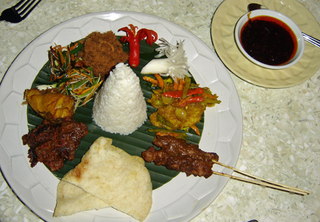
Nasi campur, also known as nasi rames or sego campur in Java, refers to an Indonesian dish of a scoop of nasi putih accompanied by small portions of several other dishes, which includes meats, vegetables, peanuts, eggs, and fried-shrimp krupuk. Depending on the origin, a nasi campur vendor might serve several side dishes, including vegetables, fish, and meats. It is a staple meal from Indonesia and popular in Malaysia, Singapore, Brunei, and southern Thailand, and also the Netherlands through its colonial ties with Indonesia. A similar form called chanpurū exists in Okinawa.
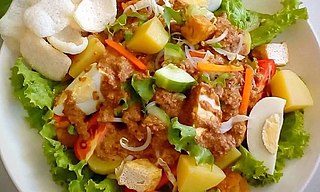
Gado-gado is an Indonesian salad of raw, slightly boiled, blanched or steamed vegetables and hard-boiled eggs, boiled potato, fried tofu and tempeh, and sliced lontong, served with a peanut sauce dressing.

Nasi tutug oncom or sometimes simply called tutug oncom, is an Indonesian style rice dish, made of rice mixed with oncom fermented beans, originally from Tasikmalaya, West Java. It is usually wrapped in banana leaves and served with various side dishes.

Lontong balap is an Indonesian traditional rice dish, well known in Javanese cuisine, made of lontong, tauge, fried tofu, lentho, fried shallots, sambal petis and sweet soy sauce. East Javanese lontong and tofu recipes are known of their distinctive flavour, acquired from generous amount of petis. The origin of the dish is from Surabaya in East Java, Indonesia.


















